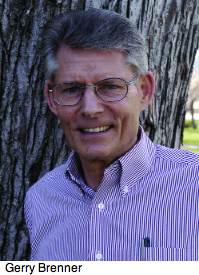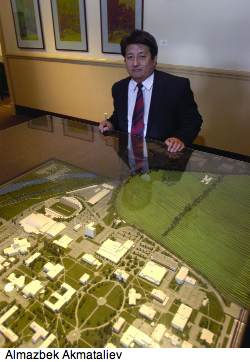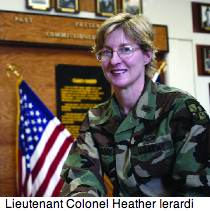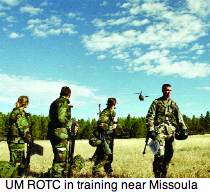Around The Oval
Greetings From the President
 This issue of the Montanan features a discussion of rising concern within American society. In Montana we often assume mistakenly that things happen only to us, not to the rest of the country. In other respects, we frequently tend to suspect comparisons, believing that Montana and Montanans have no comparators. What matters, as people say, has to do with actual experience, not with so-called peer comparisons. Nonetheless, even Montanans cannot escape the reality of modern life. Emerging trends affect us as they affect other Americans and we ignore them at our peril.
This issue of the Montanan features a discussion of rising concern within American society. In Montana we often assume mistakenly that things happen only to us, not to the rest of the country. In other respects, we frequently tend to suspect comparisons, believing that Montana and Montanans have no comparators. What matters, as people say, has to do with actual experience, not with so-called peer comparisons. Nonetheless, even Montanans cannot escape the reality of modern life. Emerging trends affect us as they affect other Americans and we ignore them at our peril.
Access to higher education has emerged as one of the significant national concerns of the twenty-first century. Increasing numbers of people, probably the majority of Americans today, worry about access to higher education for their children in view of rising costs: witness the debates in congressional committees about the reauthorization of the Higher Education Act. But most people, even those who claim to be informed, have little understanding of the factors that explain the recent and rapid increases in tuition.
As states have responded to needs in other sectors of society, they have reduced the percentages of total budgets allocated to support higher education. With only two basic sources of support—state appropriations and student tuition—colleges and universities have had to rely on tuition increases in order to assure access for those qualified to benefit from an education of appropriate quality in this increasingly technological world. When state support lags, tuition rises and that tends to occur during difficult economic times when people have fewer resources to deal with the resultant burden.
Clearly, we need a new approach, one that builds on the universal agreement about the direct and close relationship between a vibrant and responsive system of affordable higher education and a robust economy. We cannot have one without the other, and we cannot simply assume that one will automatically stimulate the other. Rather we must have deliberate policies that recognize the symbiotic relationships and build upon them. The time has come for some new thought about an institution responsible for the justly acclaimed accomplishments of American (and Montanan) society.
![]()
George M. Dennison ’62, M.A. ’63
President
The Present Meets the Past
 On May 11, UM’s Montana Museum of Art and Culture opens a four-month exhibit of An Artist with the Corps of Discovery, The Lewis and Clark Suite, by Charles Fritz. The show consists of sixty-five paintings of Corps of Discovery historic scenes depicted in today’s landscapes.
On May 11, UM’s Montana Museum of Art and Culture opens a four-month exhibit of An Artist with the Corps of Discovery, The Lewis and Clark Suite, by Charles Fritz. The show consists of sixty-five paintings of Corps of Discovery historic scenes depicted in today’s landscapes.
The UM exhibit launches a three-year, nationwide tour. “It’s the largest undertaking this museum’s ever done,” says its new director, Nelson Britt, noting the promotion, publication, insurance, and security challenges involved in the tour.
Other venues over the next two years will include the C.M. Russell Museum in Great Falls; the Yellowstone Museum of Art in Billings; the Oregon Historical
The Sun Also Rises
on Prof. Gerry Brenner
 Gerry Brenner, a retired UM English professor, became the fourth consecutive UM faculty member to receive the Montana Professor of the Year award when he was tapped for the 2003 honor by two national associations: the Carnegie Foundation for the Advancement of Teaching and the Council for the Advancement and Support of Education.
Gerry Brenner, a retired UM English professor, became the fourth consecutive UM faculty member to receive the Montana Professor of the Year award when he was tapped for the 2003 honor by two national associations: the Carnegie Foundation for the Advancement of Teaching and the Council for the Advancement and Support of Education.
The prestigious honor recognizes one professor from each state for outstanding teaching at the undergraduate level. The three previous UM professors who received the award were: Esther England (music), John Photiades (economics), and Merhdad Kia (history).
UM President George Dennison nominated Brenner for the award last spring during his final semester of teaching. In his nomination letter, submitted with letters of support from several generations of former students, Dennison cited Brenner’s “profound love of teaching, his skill in the profession, and his passion for the subjects he teaches” as characteristics that distinguish him as a respected professor among students and colleagues alike.
This reporter has her own memories. Back in 1979 during my first semester of graduate school, I signed up for Gerry Brenner’s Ernest Hemingway course against the advice of wiser, savvier master’s candidates. “You’ll want to ease into the program,” my fellow students suggested. “So don’t, whatever you do, start out with Brenner.”
Oh, come on. How hard could it be?
“He goes well beyond conveying information to students,” Dennison wrote. “He insists that the students become engaged, and he has refined methods of encouraging them to think critically.”
Professor Brenner was brilliant, engaging, provocative, and exacting. Not far into the course, he assigned the class a literary criticism paper, the first of four.
An internationally recognized authority on Ernest Hemingway, Brenner has written four books on the Pulitzer Prize-winning author. He also has published dozens of articles in scholarly journals and delivered professional literary presentations at regional, national, and international conferences.
Armed with stacks of journals, professional theses, and research books, I began to weave
together a net of other scholars’ jewels. I plucked cogent sentences from here, blinding insight from there, scribbling my notes on color-coded index cards, and collecting an impressive amount of documentation. Several weeks later I turned in a twenty-page, meticulously footnoted, loftily titled tome, an amalgam of the finest literary opinions on one of the most raked-over Hemingway themes: the religious symbolism found in The Old Man and the Sea.
“For these reasons,” Dennison concluded, “he has become a memorable teacher and friend, albeit a demanding one, to many graduates who continue to correspond with him many years after leaving the University.”
To my intense displeasure and astonishment, Professor Brenner gave me a C for my efforts, along with an admonition: “You will have to come up with some original thoughts if you expect to do well in my class, Ms. MacDonald.”
Brenner nailed it: I’d been so busy gathering the ideas of others, I’d neglected to come up with any of my own. That C infuriated, humbled, challenged, and changed me. I’ll never forget it. Or Gerry Brenner.
- Paddy MacDonald
Not Just Another Pretty Hamstring
 Athletes at UM excelled not only in the sports arena this year, but netted some impressive academic achievements as well.
Athletes at UM excelled not only in the sports arena this year, but netted some impressive academic achievements as well.
During fall semester 2003, the student-athlete grade-point average was 2.92, and nearly half the students earned a 3.0 or higher GPA. Of UM’s 325 athletes, thirty-nine made the Dean’s List, which requires at least a 3.5 GPA; twenty-three of those students earned a perfect 4.0.
The women’s cross country/track team earned the highest GPA with an average of 3.51. The women’s basketball, golf, track, and tennis teams, as well as the men’s tennis team, earned GPAs of 3.0 or higher. The men’s basketball team earned a 2.57 average GPA, and nearly half of UM’s Grizzly football team earned GPAs of 3.0 or higher.
“I am particularly pleased with the academic performance of UM’s student-athletes this past semester,” says Jean Cornwall, UM assistant athletic director for Compliance and Academic Services. “Every semester the student-athlete GPA remains steadily high. I am incredibly proud of each and every student.”
A Step Closer to Nailing Those Weather Forecasts
 The University’s Numerical Terradynamic Simulation Group’s latest research plum, an estimated $5 million mission from NASA, could help you plan a ski vacation, know if your house may be flooded in the spring thaw, or help you decide when to plant your garden. But don’t get excited yet; it will take a few years. The mission’s HYDROS satellite is set to launch in 2009.
The University’s Numerical Terradynamic Simulation Group’s latest research plum, an estimated $5 million mission from NASA, could help you plan a ski vacation, know if your house may be flooded in the spring thaw, or help you decide when to plant your garden. But don’t get excited yet; it will take a few years. The mission’s HYDROS satellite is set to launch in 2009.
UM’s researchers, leaders in developing Earth monitoring software, will produce software for the HYDROS satellite, which will study the Earth’s freeze-thaw transition and soil moisture on a daily basis. The team will write code for the freeze-thaw portion of the mission and will distribute the resulting data once the satellite is in orbit.
Running says studying the Earth’s freeze-thaw characteristics on a global scale should lead to improved weather forecasting, better flood prediction, and a keener understanding of how spring thaws trigger the growing season.
“This really takes us into the next generation of remote-sensing research,” says Running. “We thought this Earth-monitoring product up from scratch and we are going to produce it here and distribute it here from the beginning. This will be the most original work our lab has ever done.”
Running and John Kimball, a faculty member based at UM’s Flathead Lake Biological Station, will be co-investigators in the project. The other half of the HYDROS satellite science, the soil moisture component, will be handled by scientists at Princeton University, Goddard Space Flight Center, and the Massachusetts Institute of Technology.
The NTSG group has designed software for two other satellites: Terra and Aqua, which are part of NASA’s Earth Observing System. Terra, four years into a six-year mission, measures Earth’s soil, vegetation, and related indicators, and Aqua, launched three years ago, measures rainfall, snow, sea ice, temperature, humidity, vegetation, soil moisture, and clouds.
Peace Corps Friendly
The Peace Corps has released its 2004 list of “Top Producing Colleges and Universities,” and UM-Missoula has again made the top ten in the category for medium-sized institutions.
UM, with thirty-five volunteers, ranked tenth nationally among colleges with undergraduate enrollments between 5,001 and 15,000. Last year UM, with thirty-two in the corps, tied for tenth place with Stanford University. This year’s ranking puts UM ahead of institutions such as Notre Dame, Yale, and Harvard. Montana State University-Bozeman finished in twenty-third place with twenty-five volunteers in the program.
Institutions that headed the list this year had an average of fifteen percent more volunteers than last year, reflecting a growing trend of more college graduates joining the Peace Corps.
The University of Wisconsin at Madison topped the list for the tenth year in a row with 142 volunteers, up from 123 last year.
“We at Peace Corps are pleased and excited that an increasing number of college alumni are not only considering Peace Corps, but are answering the call to service that is so necessary and imperative in our global community,” says Director Gaddi H. Vasquez. Since the Peace Corps was founded in 1961, more than 170,000 Americans have served in 137 countries. At present, the Peace Corps has 7,533 volunteers and trainees in 137 countries worldwide.
Greenough Stories
Those readers who sent in reminiscences of Greenough Park may be wondering if their gems ended up in a circular file. Rest assured, they did not. Selected submissions will be featured in our next issue. And we will consider more submissions until May 1. We also would like to encourage readers to send images, photos, or fine art of the park that we may use with the stories. Send them to: The Montanan, 315 Brantly Hall, The University of Montana, Missoula, Montana 59812.
Kyrgyzstan Scholar Studies UM’s System
 Your students do such good work here,” says Almazbek Akmataliev, citing one of the positive experiences he’s had while at UM. Akmataliev, head of Naryn State University in Kyrgyzstan, spent five months this year as a visiting Fulbright scholar, learning about American higher education. “And the students have such respect for their teachers,” he adds.
Your students do such good work here,” says Almazbek Akmataliev, citing one of the positive experiences he’s had while at UM. Akmataliev, head of Naryn State University in Kyrgyzstan, spent five months this year as a visiting Fulbright scholar, learning about American higher education. “And the students have such respect for their teachers,” he adds.
Rector Akmataliev came to UM in October 2003 at the invitation of President
George Dennison, who traveled to Kyrgyzstan the previous year to sign a collaborative agreement with Naryn State University, solidifying the university leaders’ commitment to cooperate on issues and programs of mutual concern.
From October 2003 to March 2004, Akmataliev studied the entire university system, focusing on strategic management, academic enhancement and evaluation, and professional development of administrators and faculty members. His goal was to help create a more effective higher education system in Kyrgyzstan.
“I hope to change and improve the curriculum, credit hours, financial management, all parts of my university’s system,” Akmataliev says, noting that UM’s 100-year-plus traditions make it a superb model for Naryn, which is eight years old and has 4,000 students.
Akmataliev was impressed not only by the quality of UM’s students, but also by the professors, particularly their approach to learning. “It’s more interactive here,” Akmataliev says. “More discussion, questions, and answers.”
Naryn State University already has begun participating in UM’s Central Asian program. Talai Kazpekov, head of Naryn’s international program, spent several months at UM this past academic year. And as part of the collaborative agreement, Akmataliev plans to establish a Center for American Studies at Naryn on his return to his native country.
Kyrgyzstan gained independence from the Soviet Union in 1991. With a population of just under five million in a country about the size of South Dakota, Kyrgyzstan is working to develop a modern, competitive, and financially self-sufficient system of higher education. The Central Asian country faces obstacles including a remote, mountainous terrain, a low standard of living, and a poor telecommunications structure.
And the Envelope, Please
UM’s University Relations, Alumni Association, and Admissions and New Student Services departments won a basketful of awards in regional and national competitions this spring.
University Relations’ team of journalists returned from a CASE (Council for the Advancement and Support of Education) conference in Portland with six awards. UM Web Content Manager Patia Stephens was honored as a “Rising Star” in the communications field; freelance writer Tom Lutey and Montanan editor Joan Melcher received a gold award for a story of Jess Roskelley’s ascent of Mount Everest (Spring 2004); Rita Munzenrider, director of the department, garnered a silver award for the President’s Report 2003; Paddy MacDonald, writer and editor for the department, won a silver award for her story on a UM alum fire incident commander (Montanan Winter 2003); photographer Todd Goodrich was honored with a silver award for a photo used in the President’s Report; and Vision editor Cary Shimek and Montanan editor Joan Melcher received bronze awards for their publications.
Julie Schwartz, associate director of UM’s Alumni Association, also was honored as a Rising Star in the alumni relations field. This is the first year that one institution has had two Rising Star winners.
In the national Admissions Marketing Advertising Awards competition, the University’s Total Public Relations Program on Monte, the Capital One National Mascot, won a Best of Show award and a gold award; the President’s Report 2003 also won a gold and University Relations received three merit awards. Admissions and New Student Services received a silver award for a recruiting poster and a bronze for its total recruitment package.
ROTC and Commander Make the Marks
 UM’s Reserve Officer Training Corps achieved a “personal best” in 2003 with a ninth ranking in the nation, led by the University’s first woman commander, Lieutenant Colonel Heather Ierardi.
UM’s Reserve Officer Training Corps achieved a “personal best” in 2003 with a ninth ranking in the nation, led by the University’s first woman commander, Lieutenant Colonel Heather Ierardi.
The UM program was one of 271 ROTC programs ranked by the Cadet Command at Fort Monroe, Virginia. The rankings are based on cadet performance and how well each school meets it missions. UM’s ROTC exceeded its mission to commission fifteen lieutenants out of its program into the active military when it commissiond twenty-one new officers in 2003.
“This speaks to the quality of our students and the success of our training program,” says Ierardi. “Our mission is to recruit quality students, train them, and give them the skills necessary to be officers.”
Ierardi is one of less than a dozen women to chair one of the 270 military science departments in the country. A twenty-one-year veteran of the U.S. Army, Ierardi says she feels right at home leading UM’s seventy-five member Grizzly Battalion. “I haven’t noticed any obstacles, but then I’m not looking for them,” she says. “I feel very accepted.”
Ierardi served in the Middle East during the Gulf War and in Kosovo as part of United Nations peacekeeping forces. Her last assignment was in Germany with the 1st Armor Division.
 Ierardi holds several awards and decorations, including the Bronze Star, a Meritorious Service Medal, and an Army Commendation Medal, the latter two with three oak leaf clusters.
Ierardi holds several awards and decorations, including the Bronze Star, a Meritorious Service Medal, and an Army Commendation Medal, the latter two with three oak leaf clusters.
In her second year at UM, Ierardi says she thoroughly enjoys both her teaching experience and living in Montana. “I think my own experiences can only help when it comes to teaching,” she says. “And it’s a good chance for me to develop new skills by working in a completely different environment.”
Although she acknowledges she probably would not have lived in Montana had she not received her current assignment, she adds, “This is a great place to live. And this is the type of university I would like my children to attend.” Ierardi, a Nebraska native, lives in Missoula with her husband and two children.
In order to continue her military career, Ierardi will leave when her three-year assignment expires in 2005. She already has been accepted into the prestigious Army War College in Washington, D.C., where she will receive advanced training.